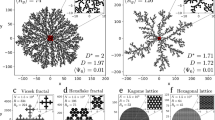Abstract
FRACTURES in the Earth's crust have a fractal structure over a wide range of length scales. A micromechanical model has been proposed1 for the formation of fractal patterns of fragmentation in fault zones, based on the preferential fracture, at all length scales, of neighbours of a particle that have the same size as the particle itself. Here we explore this model in two and three dimensions using computer automata which implement these nearest-neighbour fracture rules. The automata produce random fractals which have capacity dimensions between 1.1 and 1.7 in two dimensions, and between 2.0 and 2.8 in three dimensions, the precise value depending on the packing geometry and the presence of long-range interactions imposed by uniform strain conditions. The fractal fragmentation patterns observed in natural systems tend to have dimensions between 2.5 and 2.7; we suggest that our model may permit an interpretation of these values in terms of the packing configuration (number of nearest neighbours) of the constituent particles.
This is a preview of subscription content, access via your institution
Access options
Subscribe to this journal
Receive 51 print issues and online access
$199.00 per year
only $3.90 per issue
Buy this article
- Purchase on Springer Link
- Instant access to full article PDF
Prices may be subject to local taxes which are calculated during checkout
Similar content being viewed by others
References
Sammis, C. G., King, G. & Biegel, R. Pure appl. Geophys. 125, 777–812 (1987).
Barton, C. C. & Hsieh, P. A. Am. geophys. Union Guidebk T385, (1989).
Barton, C. C. in Fractals and their Use in the Earth Sciences (eds Barton, C. C. & LaPointe, P. R.) (GSA Memoir, in the press).
Davy, P., Sornette, A. & Sornette, D. Nature 348, 56–58 (1990).
Sornette, A., Davy, P. & Sornette, D. Phys. Rev. Lett. 65, 2266–2269 (1990).
Bak, P. & Tang, C. J. geophys. Res. 94, 15635–38 (1989).
Biegel, R. L., Sammis, C. G. & Dieterich, J. H. J. struct. Geol. 11, 827–846 (1989).
Hoffman, N. & Schönert, K. Aubereit Tech. 12, 513–518 (1971).
Baker, G. L. & Gollub, J. P. Chaotic Dynamics 112–119 (Cambridge University Press, 1990).
Author information
Authors and Affiliations
Rights and permissions
About this article
Cite this article
Steacy, S., Sammis, C. An automaton for fractal patterns of fragmentation. Nature 353, 250–252 (1991). https://doi.org/10.1038/353250a0
Received:
Accepted:
Issue Date:
DOI: https://doi.org/10.1038/353250a0
This article is cited by
-
Dynamic mechanical behaviors of coral sand under drop weight impact
Acta Geotechnica (2024)
-
A two-vertex theorem for normal tilings
Aequationes mathematicae (2023)
-
Particle breakage of granular soils: changing critical state line and constitutive modelling
Acta Geotechnica (2022)
-
Fractal Characteristics of Drilling Particle Size Distribution of Shale: A Laboratory Scale Investigation
Rock Mechanics and Rock Engineering (2022)
-
A discrete time evolution model for fracture networks
Central European Journal of Operations Research (2022)
Comments
By submitting a comment you agree to abide by our Terms and Community Guidelines. If you find something abusive or that does not comply with our terms or guidelines please flag it as inappropriate.



